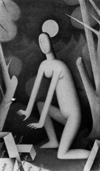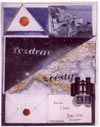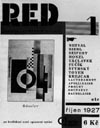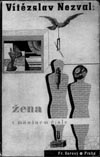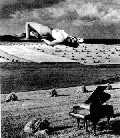 |
Vol 2, No 7 21 February 2000 |
|
|
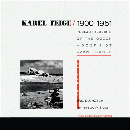 B O O K R E V I E W:
B O O K R E V I E W: Karel Teige/1900-1951 L'Enfant Terrible of the Czech Modernist Avant-Garde edited by Eric Dluhosch and Rostislav Švácha MIT Press, Cambridge (Massachusetts), 1999 440 pp, 180 illustrations ISBN 0-262-04170-7 Sue Bagust The importance of this book, a scholarly but beautifully produced examination of the work of Karel Teige, is paralleled by the emerging importance of Teige himself. One of the influential figures of international modernism, his work and art have been neglected due to its original publication in a minority language, as well as by the ideological barriers that for so long seperated Eastern from Western Europe. For a long number of years this artist / thinker / editor / typographer / architectural-theorist was like a lake into which many of the major rivers of international modernism flowed - a lake that in turn fed the culture of his native country. Teige read voraciously and travelled widely to gain a first hand knowledge of the aesthetics of his time. He visited all the major Russian and European cities and not only studied cubism, surrealism, Russian constructivism and the aesthetics of the Bauhaus but fostered relationships with the major proponants of these art forms. He published in the German expressionist journal Die Aktion, collaborated with Le Corbusier and Walter Gropius, gave lectures at the Bauhaus, and knew personally artists working in Paris such as Constantin Brancusi, Pierres Albert-Birot and Man Ray. Even though his influence in his own country was considerable, Teige was truly a part of the international modernist movement. In spite of this astonishingly intense involvement in the international aesthetic debates of his day any mention of Teige in the standard histories of modern art in the English language is hard to find. This book goes a long way towards filling this gap that has been left in the history of European modernist art and aesthetics. Written mainly by Czech speaking scholars, the book is made up of a number of articles, each representing a different segment of Teige's life and work. To do justice to all the aspects of Teige's varied and prolific output is a feat in itself. In spite of the range of Teige's talents, all the different facets of his passionate interaction with the aesthetics of his day boils down to a single aim: to bring about an interface between the art and the politics that he believed in. A modern tragedy Although Teige never became a member of the Communist Party he was a committed Marxist all his life and to a large extent the story of his interaction with the society he belonged to is the story that is traced in this book. As Eric Dluhosch says in the foreword: "...and what about the past? Should we bury it, or judge it? Or simply tell its tale? It is the latter course that the editors have decided to pursue in telling the story of Karel Teige, a true child of the twentieth century..." This is the story of a man who tried to change the world by subverting moral and artistic values in the cause of what he hoped would be a better society and who ended up being crushed by those who - at first sight - also appeared to be working for a better society. Such was the difference between Teige and the Communists that on his death in 1951 state officials confiscated all the manuscripts and writings that they could find in Teige's apartment.
The book is arranged in 14 chapters which trace the development of Teige's life and aesthetics through separate essays that delve into the various aspects of his work. The essays are preceded by an introduction by Kennth Frampton who sets Teige's work in its historical context and introduces Teige's vision.
In an essay of this year Teige asserted the loss of the autonomy of painting; in Teige's circle this loss was replaced by the poster and the Devětsil picture poem. (This is explored in detail by Srp, with many illustrations). Poetry and typography The essays that follow this chapter on the early history are mostly dedicated to delving into the art forms that came out of Teige's formative years. These are developments of existing genre but all are accompanied in Teige by intense theorising.
Chapter 4 is a translation of the complete manifesto "Poetism", written by Teige. In this Teige's definition is engineered to embrace a wide range of genre - it is not literature, it is not painting, it is not an "ism," it is not "art" in the traditional sense, says Teige - it is everything:
Chapter 11 is an essay by Srp on the artistic and political developments surrounding Teige and the Devětsil in the 1930s - by which time it had become a "highly regarded art association gathering together writers, artists, architects, actors and musicians." This period, however, was one of conflict and turmoil. Among other things it saw the formation of a new group: the Left Front which maintained "a clear and unambiguous confrontational position directed against the ruling official ideology."
Teiges important contribution to architectural theory is documented in three essays: one on Teige as the theoretician of the architectural avant-garde is by Rostislav Švácha; in another, Eric Dluhosch writes on Teige's minimum dwelling as a critique of modern architecture; while the third is devoted to an essay on Teige's troubled relationship with the CIAM - the international congress that met to promote modern architecture. Chapters 4, 6, 9, and 14 are translations of Teige's own theoretical works: "Poetism"; "Modern Typography"; "The Minimum Dwelling and the Collective House"; " The Inner Model". These are translated by Alexandra Büchler. These essays demostrate Teige's importance as part of the international avant-garde and the centrality of modernist ideas to his own thinking. There is also a detailed chronology assembled by Rumjana Dačeva; a description of "Uncle Teige" by Miloš Aulický; a bibliography and a useful guide to Czech pronunciation. A new view of modernism This book, and not least the essays of Teige published in it, places Teige among those powerful figures of modernism who believed that their beliefs could change the world. For such people the world was ever new - a series of artistic discoveries that would bring about enlightenment and a better society. For Teige, working from his position of Marxist historicism, the poetism of the Czech Devětsil was the true culmination of the international avant-garde - the last step on the way through Charles Baudelaire and Guillaume Apollinaire with whom words and all kinds of visual material could become direct initiators of emotion. The struggles for an ideal art form in Czech-speaking society is described in full colour in these essays. This description is worthwhile in itself because it lets us enter an unfamiliar world. Besides being a history of the work of Karel Teige though, it is also a wider history of the leftist avant-garde community that he was part of and the story of the struggles of this community to reconcile the art of the creative individual with the constraints of party ideologies. The potential for fruitful comparisons between this world and the more heavily documented modernist movement of the West is immense. The parallels between Teige's ideas and the modernist theories of Adorno and Walter Benjamin are the obvious ones but there are many others. The strategy of the editors to commission articles that simply but deeply present the facts results in a presentation of the "raw material" for academics who want to pursue further work on Teige. This book is sure to become a springboard for scholars who want to develop this potential of exploring the insights of Teige and the Czech avant-garde. It is also book that is accessible for a more general audience. It is superbly illustrated and set out and is model of design that mirrors Teiges own ideas on the importance of the book as a source of visual pleasure. Sue Bagust, 21 February 2000 Links An excellent collection of Teige's book covers can be found in the Williamson Gallery virtual exhibition Order Karel Teige/1900-1951: L'Enfant Terrible of the Czech Modernist Avant-Garde from:
Or click here to buy it from the UK.
|
|
![]()
Copyright © 2000 - Central Europe Review and Internet servis, a.s.
All Rights
Reserved
